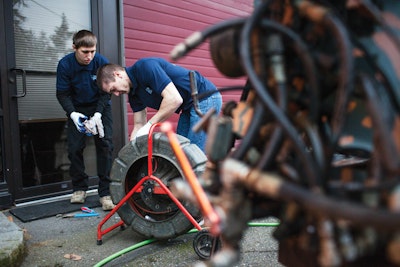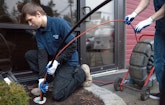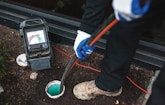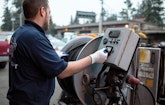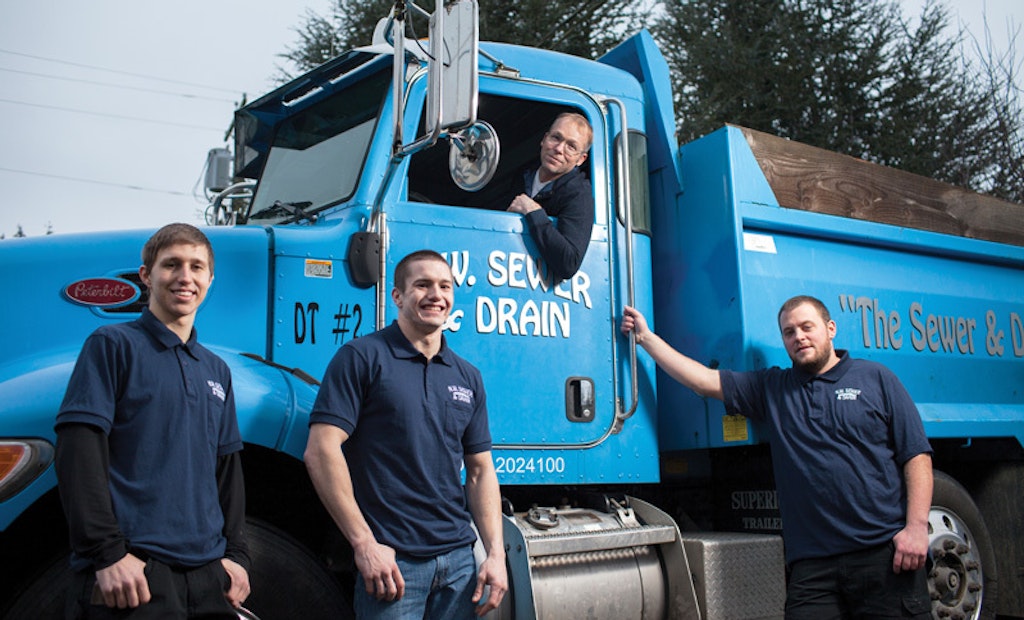
Interested in Relining/Rehab?
Get Relining/Rehab articles, news and videos right in your inbox! Sign up now.
Relining/Rehab + Get AlertsSpencer Chynoweth went from painting airplanes to excavation work, and then, with some encouragement from friends, launched his drain cleaning business in 2001.
As an entrepreneur, it’s not a path he recommends. He had little background in the industry. He had to dig his way through the newest technology and the challenges of developing a customer base, but he had the grit and determination to pull it together and make a name for his company. Along the way, his expertise grew and he learned how to run a crew efficiently.
When he formed N.W. Sewer & Drain in Seattle, Chynoweth’s goal was to target lateral work for residential customers. Pipe bursting was one of his first moves into newer technology. He bought a system from Vermeer and dove into the process.
He built his customer base significantly by contacting local plumbing companies to offer services they weren’t prepared to invest in or provide. If Chynoweth saw a plumbing van driving down the street he would note the telephone number and call the company to explain what he could provide as a subcontractor or referral company for specific needs.
If he noticed a community was getting ready to install sewer lines where homes had been on septic systems, he was there offering his help to homeowners.
Serving contractors
Working with other contractors has been a key piece of N.W. Sewer & Drain’s growth and evolution.
“Clearly the most important things we did in the beginning were to work in conjunction with other firms — the plumbing contractors, excavation contractors — and to offer trenchless pipe repair. Many of those first customers have become an integral part of the customer base. Then we also had word-of-mouth.”
Working as a subcontractor has provided opportunity for the business, but it also presents additional challenges.
“The most important thing is for us to do the best job possible when we have been recommended for a job, because we are a reflection on the other firm,” Chynoweth says. “Whether they just hand us the job and say ‘take care of our customer’ or if we work in a partnership where they pay us as a subcontractor.
“We have to use our own good morals and communicate that we are not out to steal a customer.”
Creating a name
Building the company name has required more than just developing relationships with other contractors.
“Advertising is a very expensive thing. It requires many different approaches to keep up with the competition. That’s what we try to do,” Chynoweth says.
Creating a company website helped the company establish a stronger presence, but Chynoweth says it’s not a magic bullet. “Nobody goes to a website unless they’re an existing customer, and then they already know about you. Getting new customers on a website is a whole different matter. You have to hire an expert or a special service.”
In the end, he says it’s the customer who holds the ultimate power over the success and growth of any company because they share both good and bad experiences with others.
“Having satisfied customers is huge. You cannot please everyone, but it is critical to deal with an unhappy customer in the best way you possibly can to avoid criticism online. I recently had a complaint from a customer, although I had provided a copy of the video inside the sewer pipe, provided a map of where it was and how deep it was. He was not happy.
Protecting the reputation is so important. We worked out a solution. That was fortunate.”
The company is listed on Angie’s List, and earning several Super Service awards has helped build a strong reputation. Chynoweth also recently joined the local PHCC chapter, which has provided another avenue to promote drain cleaning and other specialized services to plumbing companies.
Going trenchless
Early on, Chynoweth would hire another firm to come in and inspect lines, but he eventually bought a camera and then a jetter in 2008. They were pricey items, but as he grew the company and customer base he was able to buy equipment and add services. He also purchased relining equipment from Perma-Liner Industries to go along with the Vermeer bursting equipment.
The company also offers waterline replacement through the use of directional drilling. Trenchless work in general is essential to the area they serve and currently accounts for about 50 percent of business.
They see a variety of pipes, from terra-cotta clay to concrete to Orangeburg. If a line is in very bad condition, pipe bursting can be the better option, but relining is still the more common approach. Chynoweth says evaluating the best way to handle a job can be extremely challenging. Each project is different, and so are the solutions.
Local sewer lines are often buried quite deep, up to 18 feet, and homes are often very close together, so digging up deep sewers for replacement is a monumental challenge as well as a safety issue.
“We do very little excavation to replace sewer lines,” he says. “We do excavation as required for pipe bursting or relining.”
The company also offers waterline replacement through the use of directional drilling, and standard cleaning and inspection work are another big part of the equation.
“In addition to our camera work and jetting, we offer locating and diagnostics to learn the condition of the sewer lateral,” he says. “If the sewer line is backed up, our job is to find the solution. We do a lot of hydrojetting.”
He now has two jetters, one from O’Brien (Hi-Vac) and another from Mongoose, both producing 4,000 psi/18 gpm.
The company handles its excavation work with four Kubotas, one Bobcat and a large Komatsu. His vehicles include a Ford Econoline, Dodge Sprinter, an Isuzu box truck and a Nissan van. He uses the Nissan for estimating and camera work, and a Freightliner step van carries all the lining equipment.
Staffing up
Like most owner/operators, Chynoweth is very selective in who he hires, and finding qualified technicians who meet his standards is a challenge.
“I have equipment that is not being used right now because of the difficulty in finding more qualified crews. At every meeting I attend, this is discussed and lamented.”
As a boss, Chynoweth likes to lead by example. He says he’s more than willing to get into the trenches and work with his team.
“I have spent a lot of time working in the field, and I don’t think anyone can learn this business without the field experience. It took years for us to really get going, but we’ve been in it long enough now so we know how important it is to keep up with the latest technology. It can certainly be a risky business.”
His crews are universal and trained in all trenchless procedures, and everyone takes part in competent person training for excavation.
Chynoweth says running the company has been very rewarding. He appreciates being able to provide valuable services while being fair to customers. He is also happy that the company can offer good benefits for the employees and their families.
“I am grateful to my employees,” he says. “I could not do it all myself. I like to know we help them and appreciate them. I like to thank them for helping our company get things done.”
Walking the municipal high-wire
Working with various cities has been a challenge for N.W. Sewer & Drain, but it has also been an important learning experience for owner Spencer Chynoweth as he has grown his drain cleaning and repair business in the Greater Seattle region of Washington.
In addition to developing the business with basic hands-on learning and experience, he has had to learn the intricacies and unique requirements of working within the various municipalities, as each has its own regulations and codes.
“Within a 5-mile radius we interact with four different cities, and each has their own set of license requirements and specifications,” says Chynoweth. “One might require 5/8-inch crushed rock around the pipe, and another want pea gravel, while the third will ask for 5/8-inch clean crushed rock. There is not a single standard for all. One city stated they would not allow pipe lining in their city, but after our working with their engineering department they added pipe lining to their specifications.”
He says they must deal with taxes, requirements for permits, insurance and much more, such as bonding and business licenses.
Chynoweth started his business with little experience in the industry, and his advice for anyone interested in starting a business is getting a job with an active company and learning before starting your own operation.
“I would never advise anyone to do it the way I did,” he says. “It was a slow beginning as I learned in the field. Beyond that, my advice would be to do your best to treat other people as you want to be treated, and that includes customers, employees, suppliers, and the competition as well.”
